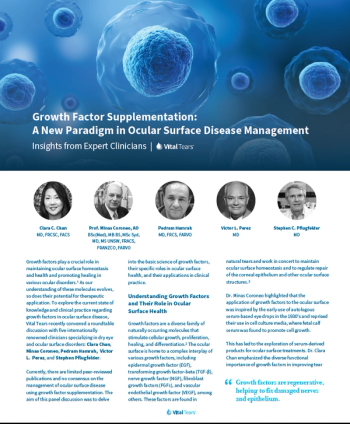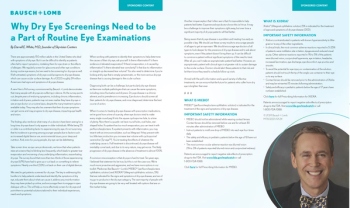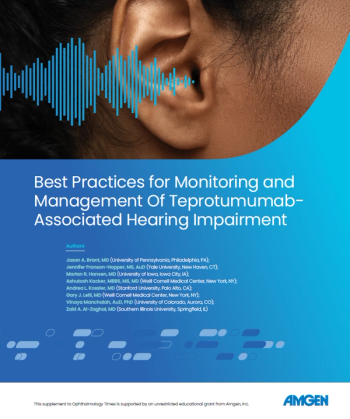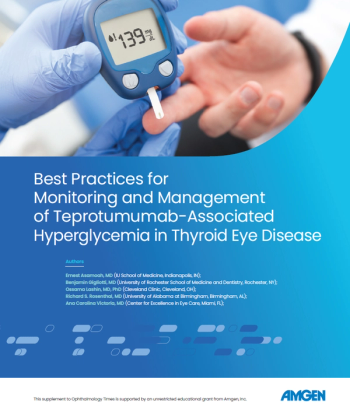
Presbyopia: A Natural Part Of Aging, Or A Frustrating Daily Challenge?
[SPONSORED] The perfect storm: an aging population and modern technology
Sponsored by Allergan, an AbbVie company
Presbyopia is a prevalent condition that affects 128 million Americans, and the numbers continue to grow.1-3 The first of 73 million millennials turn 40 this year,4 following the 61 million people in generation X, who are aged 41 to 56 in 2021—substantially increasing the potential number of presbyopes.3,5
Our increasing reliance on digital media and communication underscores the prevalence of presbyopia and serves as an almost constant reminder to presbyopes that their near vision isn’t perfect.
Normal everyday functions are seriously disrupted
Presbyopia is a progressive condition that reduces the eye’s ability to focus on near objects. The issues experienced with near vision loss are diverse, but most are associated with difficulty reading in normal everyday functions (Figure 1).9
According to a survey of 797 presbyopes aged 40 to 55, the vast majority (96%) are impacted by symptoms, with 46% reporting that they are extremely affected.9 While nearly all patients face near vision challenges, they are forced to accept changes in the daily activities they used to take for granted.
Patients rely on workarounds
According to a survey of patients aged 40 to 60, those who don’t want to use current treatment options find workarounds to compensate for vision loss, such as color-coding keys, using a magnifying mirror, and increasing the font size on their phone and computer.9 More absurd but actual workarounds that patients have turned to in desperation include using a magnifying glass to see the text on a phone, wearing 2 sets of glasses, and using an LED headlamp (Figure 2).
The struggle is real
Aside from the daily struggles and workarounds associated with presbyopia, the condition can strike at a much deeper emotional level. Presbyopia can affect the way patients feel about their own ability to take care of themselves and can make them feel old and disabled.9
Frustration with presbyopia runs high
Many presbyopes rely on nonsurgical options for vision correction, such as reading glasses, multifocal glasses, or contact lenses, and some elect to have surgery, such as LASIK, corneal inlays, lens exchange, and keratoplasty.11 However, none of these options restores the eye’s natural dynamic range of accommodation.12 Additionally, patients who wear glasses and/or contacts generally feel that they solve the problem. However, the majority indicate there is room for improvement in comfort, convenience, and aesthetics according to a survey of patients aged 40 to 60.9
Improving patient satisfaction may start with enhanced engagement
Quantitative patient study results showed that two-thirds of presbyopes saw an eye care professional (ECP) in the last 12 months and 79%of them initiated a discussion with their ECP about near vision loss symptoms (Figure 4).9 However, only half of these patients got the information they needed.9
There is an opportunity for ECPs to conduct deeper, more meaningful discussions about presbyopia:
- Use impactful dialogue to explain presbyopia
- Describe the aging eye and the cause of presbyopia in a way that patients can understand
- Allow patients to share their quality-of-life concerns and acknowledge their frustrations
- Gain a full understanding of the day-to-day impact that presbyopia has on patients’ lives
Adopting these presbyopia dialogue strategies can create better engagement with patients, which in turn can help guide treatment decisions and set realistic expectations.
These dynamics present an opportunity for productive engagement with patients now and in the future
The needs of the presbyopic population are shifting as aging generations combined with increasing reliance on digital media create a challenging new dynamic. Patients may be more frustrated with their presbyopia and treatment options than we think, presenting a significant opportunity for raising the bar in patient satisfaction. Through better understanding and engagement, we can reimagine the presbyopic patient journey.
References: 1. Care of the Patient with Presbyopia. American Optometric Association. 2011. 2. Zebardast et al. Am J Ophthalmol. 2017;174:134-144. 3. U.S. Census Bureau. Table 9. Washington: Population Division. 2014. 4. Searing. Washington Post website. https://www.washingtonpost.com/national/health-science/the-big-number-millennials-to-overtake-boomers-in-2019-as-largest-us-population-group/2019/01/25/a566e636-1f4f-11e9-8e21-59a09ff1e2a1_story.html. Accessed 2021. 5. Pew Research Center website. https://www.pewresearch.org/fact-tank/2019/01/17/where-millennials-end-and-generation-z-begins/. Accessed 2021. 6. MarketWatch website. https://www.marketwatch.com/story/people-are-spending-most-of-their-waking-hours-staring-at-screens-2018-08-01. Accessed 2021. 7. Nielsen Company website. https://www.nielsen.com/us/en/insights/report/2018/q1-2018-total-audience-report/. Accessed 2021. 8. Americans check their phones 96 times a day [press release]. https://www.asurion.com/about/press-releases/americans-check-their-phones- 96-times-a-day/. Accessed 2021. 9. Data on file, Allergan. 10. McDonnell et al. Arch Ophthalmol. 2003;121(11):1577-1581. 11. American Academy of Ophthalmology. Refractive Errors & Refractive Surgery Preferred Practice Pattern®. 2017. 12. Charman et al. Ophthalmic Physiol Opt. 2017;37:655-660.
© 2021 AbbVie. All rights reserved. All trademarks are the property of their respective owners. UNB144640 03/21 009552
Newsletter
Don’t miss out—get Ophthalmology Times updates on the latest clinical advancements and expert interviews, straight to your inbox.


















































.png)


